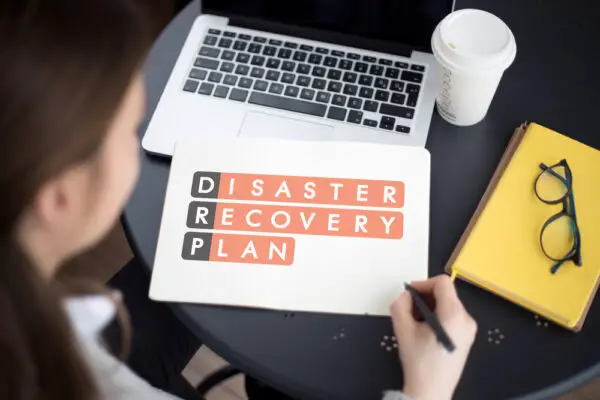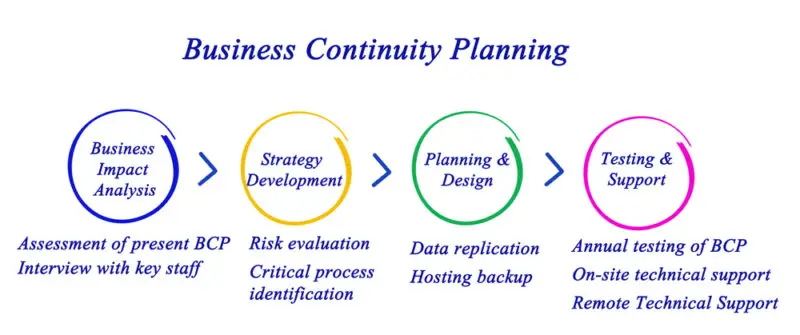Do you know what you would do if disaster struck your business tomorrow? Would you be able to keep your operations running smoothly, or would everything grind to a halt?
This is where a business continuity plan comes in. It is a crucial document that outlines how your business will continue to function in the face of a disaster or other unexpected event.
A business continuity plan is not the same as a disaster recovery plan. While a disaster recovery plan focuses on restoring IT systems and data after a disaster, a business continuity plan takes a broader approach. It covers everything from ensuring employee safety and communication during a crisis to maintaining business operations and managing financial losses.
In short, it is the blueprint for keeping your business up and running in the face of adversity. So, why do you need one? Keep reading to find out.
Business Continuity Management
Now that you understand the importance of keeping your operations running smoothly, even during unexpected events, let’s dive into managing your business’s continuity.
Business Continuity Management (BCM) is essential for all businesses, especially small ones. It entails business continuity, disaster recovery, to crisis management. A BCM will help you identify potential risks to your business and develop strategies to minimize the impact of any disruption to your operations.
A Business Continuity Plan (BCP) is an essential element of BCM. It outlines the steps your business needs to take to continue operating during disruption and recover quickly after the event.
A BCP should include a risk assessment, a business impact analysis, and recovery strategies. The risk assessment helps you identify potential risks, while the business impact analysis helps you determine the potential impact of those risks on your business. Recovery strategies help you develop plans for continuing operations during a disruption and recovering quickly after the event.
A Business Continuity Plan, you can identify potential risks, develop recovery strategies, and minimize the impact of any disruption to your operations.
Risk management is a crucial part of running a successful business, and a BCM plan is an essential tool to help you manage those risks.

Business continuity plan
You have a solid strategy to ensure your operations keep running smoothly, even in the most chaotic of times. This is where a business continuity plan comes in.
A business continuity plan is a document that outlines the steps your organization needs to take to ensure that it can continue to operate in the event of a disaster, whether it be a natural disaster, cyber attack, or any other unexpected event that could disrupt business operations.
There are a number of reasons why having a business continuity plan is important. First, it helps minimize the disaster’s impact on your organization. This means you can continue to serve your customers and clients, even amid a crisis.
Another reason why a business continuity plan is also important is that it helps protect your organization’s reputation. If you cannot provide your customers with the products or services they need, they may go elsewhere, damaging your reputation and potentially leading to a loss of business.
Additionally, having a BCP in place can help build trust with your customers, suppliers, and stakeholders. It shows that you’re committed to ensuring continuity of operations, even during times of crisis.
You can minimize the impact of any disruptions and maintain the trust of your customers and clients. So, if you haven’t already, it’s time to start thinking about the importance of a business continuity plan and how it can help your organization stay strong, even in the face of adversity.
A BCP is a critical component of your overall business continuity management strategy. It helps you prepare for and recover from disasters, ensuring that your business continues operating even during crises.
Disaster Management
Disasters can strike at any moment, leaving you vulnerable and unprepared. These unexpected events can range from natural disasters such as floods and earthquakes to human-made disasters such as cyber-attacks and power outages.
Disaster management refers to the process and measures taken to predict, prevent, prepare for, respond to, and recover from disasters. These disasters can be natural (like earthquakes, floods, and hurricanes) or human-made (such as nuclear accidents, terrorist attacks, etc.). Disaster management aims to minimize the damage caused by these disasters, protect lives and property, and ensure a speedy recovery.
There are generally four stages in the disaster management cycle:
Mitigation: This phase involves identifying potential risks and hazards and implementing measures to prevent or reduce the impact of these disasters. This can include building codes that require earthquake-resistant construction, fire-resistant materials, zoning laws to prevent building in flood-prone areas, etc.
Preparedness: Preparedness refers to the steps taken in anticipation of a disaster to facilitate an effective response and recovery. This includes developing disaster response plans, conducting drills and exercises, establishing early warning systems, and training responders.
Response: The response phase involves the immediate actions taken to save lives, minimize damage, and provide relief to affected communities during and immediately after a disaster. This can include search and rescue operations, providing medical care, distributing food and water, setting up temporary shelters, etc.
Recovery: Recovery involves the steps taken to return the affected area to its normal or improved state after a disaster. This can involve rebuilding infrastructure, restoring public services, providing psychological support to affected individuals, etc.
Effective disaster management requires cooperation and coordination between agencies and stakeholders, including governments, non-governmental organizations, the private sector, communities, and individuals.
It’s important to note that disaster management has increasingly emphasized response, recovery, mitigation, and preparedness to create more resilient communities that can withstand disasters and recover more quickly when they occur.
Disaster Recovery Plan
Get ready to quickly recover from any disaster with a disaster recovery plan. A disaster recovery plan is a key component of a business continuity plan that outlines the steps to keep your operations running smoothly during a natural disaster or other unexpected event.
It’s crucial for businesses to have such a plan to mitigate the risks of downtime and ensure that they can continue operating even in the face of adversity.
A disaster recovery plan is important for a number of reasons. Firstly, it can help you to identify potential risks and vulnerabilities in your business operations. This can include identifying areas where your business is most susceptible to natural disasters, cyber-attacks, or other unexpected events.
Secondly, a disaster recovery plan can help you to minimize downtime and ensure that your business can continue to operate even in the face of adversity. Downtime can be costly for businesses, both in terms of lost revenue and damage to their reputation. By having a comprehensive plan in place, you can minimize the impact of any disruptions to your business operations and ensure that you’re able to quickly recover and resume normal operations.
In conclusion, a disaster recovery plan is a critical component of a business continuity plan. It can help you to identify potential risks and vulnerabilities, minimize downtime, and ensure that your business can continue to operate even in the face of unexpected events.
Taking the time to develop a comprehensive plan, you can ensure that your business is prepared for anything and can quickly recover from any disaster.

Importance of a Business continuity
If you’re serious about keeping your operations running smoothly, it’s crucial to understand the significance of having a comprehensive business continuity plan in place for when unexpected events occur. A business continuity plan is a proactive approach to ensuring that your business can continue to function even in the face of unexpected disruptions.
It is a plan that guides you through the process of recovering from a disaster and minimizing the impact on your business. One of the key components of a business continuity plan is the business continuity impact analysis. This analysis helps you identify the potential risks and impacts that your business may face in the event of a disaster.
By understanding the potential impacts, you can take steps to mitigate them and develop recovery strategies that will help you recover from the disaster more quickly. This can help you avoid or minimize the loss of revenue that can occur as a result of a business interruption.
In short, having a business continuity plan is essential for any business that wants to be prepared for unexpected events. By understanding the risks that your business faces and developing a plan to mitigate those risks, you can ensure that your operations can continue to function even in the face of a disaster. This can help you avoid the loss of revenue that can occur as a result of a business interruption and ensure that your business is able to recover quickly and effectively.
Frequently Asked Questions
What are some common threats or disasters that a business continuity plan should address?
To ensure the survival of your business, it’s crucial to have a business continuity plan that addresses common threats and disasters. These can include natural disasters such as hurricanes, earthquakes, and floods, as well as man-made disasters like cyber attacks, power outages, and supply chain disruptions.
A continuity plan should include measures to protect employees, secure data, and maintain critical operations during the event of a disaster. By proactively preparing for such events, you can minimize the impact on your business and ensure that operations can resume as soon as possible.
How often should a business review and update their continuity plan?
As a business owner, it’s important to understand that having a continuity plan is not a one-time effort. It’s a continuous process that needs to be reviewed and updated regularly.
It’s recommended that you review your plan at least once a year, or whenever there’s a significant change in your business operations or environment. This could include changes in personnel, technology, or even regulatory requirements.
By regularly reviewing and updating your continuity plan, you can ensure that it remains effective in protecting your business from potential disruptions and helps you recover quickly in the event of a disaster.
What are some key components of a successful business continuity management team?
To ensure the success of your business continuity plan, you need to have a strong and capable management team in place.
The key components of a successful business continuity management team include a leader who can effectively communicate with all stakeholders, a team with diverse skills and experiences, a clear understanding of the organization’s critical processes, and a solid understanding of the risks and potential disasters that the organization may face.
It’s important to regularly review and update the plan to ensure that it remains relevant and effective, and to provide ongoing training and education to the team to ensure they’re equipped to handle any situation that may arise.
By having a strong and capable management team, your organization will be able to quickly and effectively respond to any disruption and minimize the impact on your operations and customers.
What are some best practices for communication during a disaster or disruptive event?
During a disruptive event or disaster, communication is key to ensuring that your business can continue to operate successfully. To ensure that your communication efforts are effective, there are several best practices that you should follow.
First, establish a clear chain of command and make sure that everyone knows who’s responsible for making decisions and disseminating information.
Second, use multiple channels to communicate with your employees, customers, and other stakeholders, such as email, text messages, social media, and phone calls.
Third, be transparent and honest in your communication, even if the news isn’t good.
Finally, regularly review and update your communication plan to ensure that it remains effective and relevant.
By following these best practices, you can help ensure that your business is able to weather any storm.
How can a business measure the effectiveness of their business continuity plan?
To measure the effectiveness of your business continuity plan, you should conduct regular tests and evaluations. This includes testing your plan in different scenarios and making improvements based on the results.
It’s also important to gather feedback from your team members and stakeholders to identify any areas that need improvement. Additionally, tracking the time and cost of disruptions can help you quantify the impact of your plan and make adjustments accordingly.
Remember, a well-crafted and regularly updated business continuity plan can help your organization minimize downtime, protect your reputation, and maintain business operations during unexpected disruptions.

Conclusion
So now you know why a business continuity plan is critical for any business. Without one, a disaster can wreak havoc on your company and leave you struggling to recover.
But with a well-designed plan in place, you can minimize the damage, keep your business running, and protect your assets. Remember, a business continuity plan doesn’t have to be complicated, but it does need to be comprehensive.
Start creating your business continuity plan today and give your company the best chance for success, no matter what challenges may arise.

Chris Ekai is a Risk Management expert with over 10 years of experience in the field. He has a Master’s(MSc) degree in Risk Management from University of Portsmouth and is a CPA and Finance professional. He currently works as a Content Manager at Risk Publishing, writing about Enterprise Risk Management, Business Continuity Management and Project Management.

